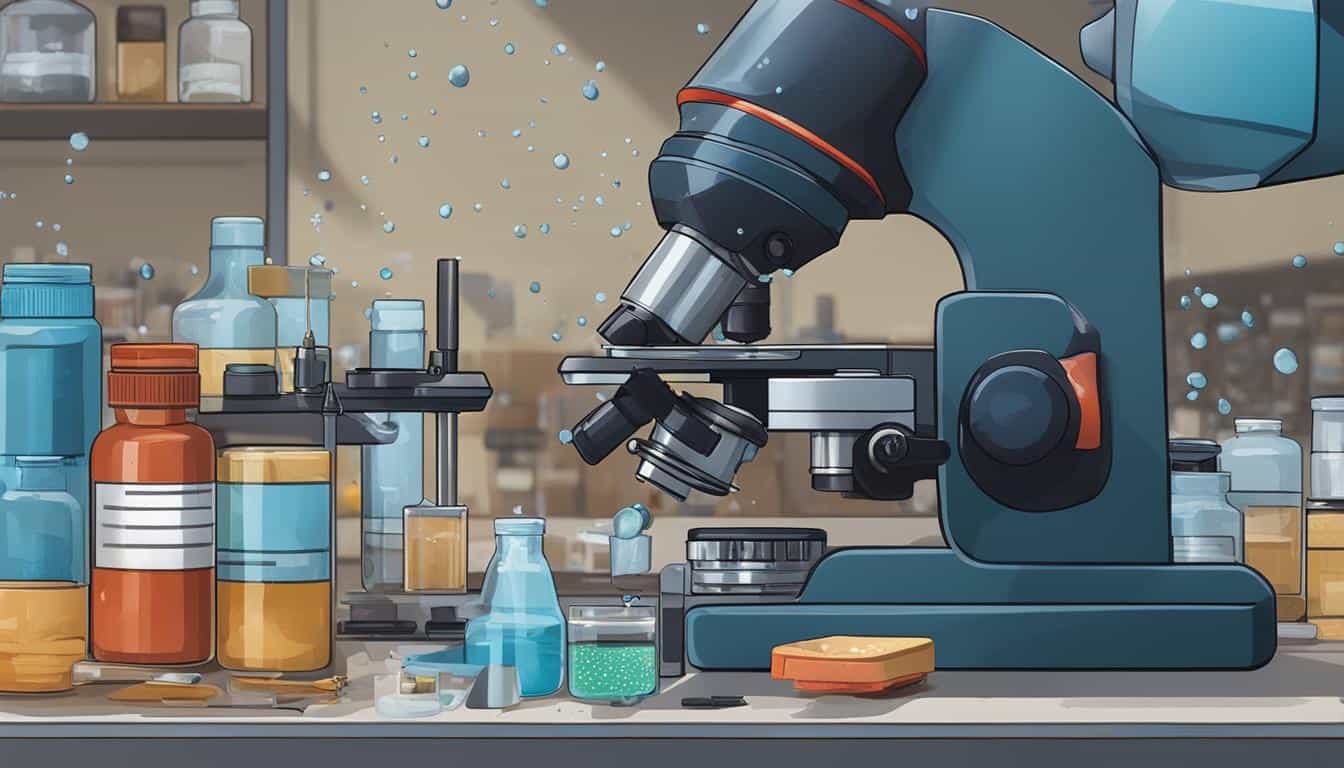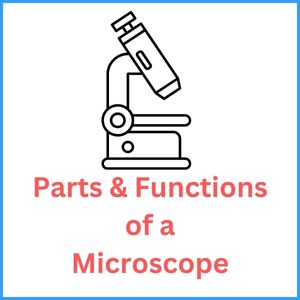I will admit I never like doing maintenance for my microscopes – mainly because I do the maintenance tasks every 2 weeks.
While it is true that proper microscope maintenance is an essential part of ownership, doing that is indeed a chore. 😏
Routine upkeep and cleaning techniques can help maintain its performance and prevent damage to a certain extent.
In this short guide, I will lay down the best practices I do for my microscopes to ensure longevity and optimal performance.
I will cover everything from handling and storage to cleaning lenses and mechanical maintenance.

Microscope Handling and Storage
Proper handling and storage of your microscope are crucial for maintaining its longevity and ensuring it functions optimally.
By following these guidelines, you can effectively extend the life of your microscope and protect it from potential damage.
Microscope Handling
When handling your microscope, always hold it by the base and the metal support arm to prevent misalignment or accidental drops.
Avoid gripping the tube or stage, as this may cause damage to the delicate components.
If you need to transport your microscope frequently, consider using a microscope carrying case for added protection.
I always cover my microscope with the dust cover when it’s not in use.
his will help prevent dust accumulation on the lenses and other sensitive parts of the microscope, which can affect its performance over time.
Dust and debris can also enter the microscope through the eyepieces, so avoid storing the microscope without eyepieces to prevent this.
Microscope Storage
To maintain the quality of your microscope, it’s crucial to store it properly.
Choose a dry and draft-free area away from corrosive chemical fumes.
High humidity can lead to the growth of mold and can cause damage to the microscope’s lenses and other parts.
Avoid storing the microscope in places with extreme temperature conditions, as this can damage its hardware components resulting in poor performance.
I use a designated storage space or cabinet that is free from dust, humidity, and other potential hazards.
Keeping your microscope in an appropriate storage environment will help prevent unnecessary wear and tear, ensuring its longevity.
10 ideal storage places
| Location | Description |
|---|---|
| Microscope Cabinet | A dedicated cabinet designed to store microscopes, often equipped with shelves or compartments for organization and protection. |
| Laboratory Drawer | A labeled drawer within a laboratory, providing a controlled environment away from dust and potential damage. |
| Cleanroom Shelving | Shelves within a cleanroom environment, maintaining sterility and protecting delicate microscope components from contamination. |
| Instrument Room | A designated room within a laboratory specifically for storing scientific instruments, including microscopes, with controlled temperature and humidity levels. |
| Desiccator | A sealed container with low humidity levels, ideal for storing microscopes in environments where moisture control is crucial. |
| Instrument Cart | A mobile cart with compartments or racks for safely transporting and storing microscopes between locations. |
| Microscope Case | A sturdy, padded case designed for transporting and storing microscopes, offering protection during travel or fieldwork. |
| Climate-Controlled Room | A room equipped with climate control systems to maintain stable temperature and humidity levels, ensuring optimal storage conditions for microscopes. |
| Fume Hood | A ventilated enclosure is usually used for handling hazardous materials, providing a safe and controlled environment for storing microscopes in certain laboratory settings. |
| Storage Closet | A dedicated closet within a laboratory for storing equipment, including microscopes, with proper organization and protection from dust and damage. |
These locations offer varying levels of protection, organization, and environmental control to ensure the longevity and performance of microscopes
Cleaning Microscope Eyepiece Lenses
Proper cleaning of microscope eyepiece lenses is essential for maintaining clear and accurate observations.
Dust, smudges, and debris can significantly affect the quality of your microscope’s image.
Here are a few of my lens-cleaning tips for ensuring optimal performance:
- Use a can of compressed air to remove any loose particles from the lens surface.
- Apply a small amount of lens cleaning solution to a piece of lens cleaning paper. Avoid using excessive liquid to prevent damage to the lens.
- Wipe the lens using gentle circular motions, and go from the center to the outer edges. This helps to remove fingerprints and smudges effectively.
- If needed, use distilled water to clean the lens. Remember to use a clean piece of lens paper and avoid excessive moisture.
- Inspect the lens for any remaining dust particles. If necessary, repeat the cleaning process.
It is important to avoid using sharp instruments or abrasive materials when cleaning microscope lenses as they can scratch the lens surface.
Regular cleaning of eyepiece lenses helps maintain the clarity and accuracy of your microscope’s image, ensuring optimal performance.
Common Lens Cleaning Solutions
| Cleaning Solution | Composition |
|---|---|
| Isopropyl Alcohol | 70% isopropyl alcohol mixed with distilled water |
| Lens Cleaning Solution | Specifically formulated solution for lens cleaning |
| Distilled Water | Purified water with impurities removed |
I always refer to the microscope’s user manual for specific cleaning instructions and recommendations.
Proper care and maintenance of your microscope’s eyepiece lenses will ensure consistent and accurate observations.
Cleaning of Microscope Objectives
Proper cleaning and maintenance of your microscope objectives can help prolong the objective Lifespan and improve image quality.
Dust and debris can accumulate on the objective lenses, affecting the quality of your observations.
Here are some important tips for cleaning and caring for your microscope objectives:
1. Determine the Need for Cleaning
Observe your microscope objective lenses closely to check for visible dust or debris.
If you notice any particles on the lenses or experience a decrease in image quality, it may be time to clean the objectives.
Cleaning should be done regularly as part of your microscope maintenance routine.
2. Use Lens Cleaning Solution and Lens Paper
Start by applying a few drops of lens cleaning solution to a clean piece of lens paper.
Gently wipe the objective lens in a circular motion, be careful not to apply too much pressure.
Avoid using sharp instruments or abrasive materials that can scratch the lens. Repeat the process if necessary to remove all dust and debris.
3. Remove Immersion Oil
If you have been using immersion oil with your objectives, you must remember to remove the oil after each use.
Immersion oil can attract dust particles and affect the clarity of your images.
Use a lens cleaning solution specifically designed to remove immersion oil, and gently wipe the lens with lens paper until all traces of the oil are gone.
4. Thorough Cleaning if Needed
If your objective lenses require a more thorough cleaning, you can use oil-soluble solvents.
These solvents are specifically formulated for cleaning microscope lenses and can effectively remove stubborn contaminants.
Follow the instructions provided by the solvent manufacturer.
Mechanical Maintenance
Proper mechanical maintenance is crucial for keeping your microscope in optimal working condition.
If unsure, consult the microscope manual before making any adjustments or maintenance.
This will provide specific instructions tailored to your microscope model, preventing potential damage.
Avoid over-tightening or use of excessive force while performing maintenance tasks to protect the delicate components.
One important aspect of mechanical maintenance is lubrication.
Apply a thin layer of lithium-based grease to the moving parts of your microscope once a year.
This will help reduce friction and ensure smooth movement of the mechanical components.
However, be cautious not to grease the teeth of the rack and pinion gears, as this can interfere with their operation.
After lubrication, check the tension of the fine and coarse focusing knobs and adjust if necessary.
Remember to regularly inspect and replace bulbs according to the manufacturer’s instructions to help ensure proper illumination during microscope usage.
By adhering to the maintenance procedures, you can extend the lifespan of your microscope and maintain its performance for years to come.
Regular Nosepiece Adjustment
The nosepiece is an integral part of the microscope that holds the objective lenses and allows the user to switch between different magnifications.
To make the necessary adjustments, locate the slot-headed screw in the middle of the nosepiece.
Loosen or tighten the screw as needed to achieve the desired positioning of the objective lenses.
This adjustment allows for precise focusing and alignment, ensuring clear and accurate observations under the microscope.
For detailed instructions on nosepiece adjustment for your specific microscope model, it is recommended to refer to the user manual provided by the manufacturer.
Following the manufacturer’s guidelines will ensure that the adjustment is performed correctly and without causing any damage to the microscope.
By mastering the technique of nosepiece adjustment, you can ensure that your microscope is always ready to deliver optimal performance and precise observations.
Regularly checking the alignment of the nosepiece and making necessary adjustments will help maintain the accuracy and clarity of your microscope’s imaging capabilities.
Adjusting the Focus Knob
Proper adjustment of the focus knob allows for clear and precise focus during observations.
By following a few simple steps, you can easily adjust the tension of the fine and coarse focus knobs to optimize your microscope’s functionality.
To begin, locate the focus knobs on your microscope.
The fine focus knob is typically smaller and located towards the center, while the coarse focus knob is larger and positioned on the side.
Start by turning both knobs in opposite directions to loosen the tension.
Next, check if your microscope has adjustable collars on the shaft of the focus knobs. If so, you can move the collars outwards to provide more tension.
This adjustment can help you find the right balance between smooth movement and precise focus.
Always refer to your microscope’s user manual for specific instructions on adjusting the focus knob and the presence of adjustable collars.
Remember, it’s important not to over-tighten or use excessive force when adjusting the focus knobs.
This can cause damage to the internal mechanisms of your microscope.
By regularly checking and adjusting the tension of the focus knobs, you can optimize your microscope’s performance and enhance the quality of your observations.
Keep in mind that specific microscope models may have different mechanisms for adjusting the focus knob, so I would always advise referring to the user manual for accurate instructions.
Lubricating Surfaces
Proper lubrication is essential for maintaining the smooth operation of your microscope’s moving parts.
Regular lubrication ensures that the mechanical components function optimally and extend the lifespan of your microscope.
To keep your microscope in top condition, follow these guidelines for lubricating the surfaces:
1. Clean the Surfaces:
Before applying lubricant, it is crucial to clean the sliding surfaces thoroughly.
Use a clean cloth to remove any grease and dirt from the areas that require lubrication.
This step ensures that the lubricant adheres properly and prevents the build-up of debris that could interfere with the smooth movement of the microscope’s parts.
2. Apply the Lubricant:
Once the surfaces are clean, apply a thin layer of lithium-based grease to the sliding components.
Lithium-based grease is ideal for microscope lubrication as it provides excellent lubrication properties and is compatible with most microscope materials.
The grease should be spread evenly across the surfaces for smooth and consistent movement.
3. Avoid Greasing Rack and Pinion Gears:
When lubricating the surfaces, it is important to avoid greasing the teeth of the rack and pinion gears.
These gears do not require lubrication and can function optimally without grease.
Applying grease to the gears can attract dust and debris, leading to potential performance issues.
Focus on lubricating the other moving parts of the microscope instead.
Regular lubrication of your microscope’s surfaces is a simple yet effective maintenance practice that ensures the smooth operation of the mechanical components.
Replacing Bulbs
One of my regular maintenance tasks is replacing bulbs for my microscopes.
Over time, bulbs can become dim or burn out, affecting the quality of your microscope’s illumination.
By replacing them promptly, you can ensure optimal lighting conditions for clear and accurate observations.
When it comes to replacing bulbs, it is essential to consult the microscope’s instruction manual for specific instructions and compatible bulb types.
Different microscope models may have different requirements, so following the manufacturer’s guidelines is crucial.
It is also important to allow the bulb to cool down before replacing it to avoid burns or damage.
When handling the bulb, avoid touching the glass with bare hands.
The oils and salts from your skin can leave fingerprints or other residues that may affect the bulb’s performance.
Instead, use a clean cloth or gloves to handle the bulb to maintain its integrity.
Dust particles can also hinder the bulb’s effectiveness, so ensure a clean environment during the replacement process.
LED bulbs are becoming increasingly popular due to their energy efficiency and longer lifespan. They generally require less frequent replacement, and their durability can help save on overall maintenance costs.
However, always refer to the microscope’s manual for specific bulb replacement instructions to ensure compatibility.
Final Words
Implementing a preventive maintenance schedule is essential in avoiding major repairs and extending the life of your microscope. Regular cleaning, routine maintenance, and adherence to the manufacturer’s recommendations will keep your microscope in good working condition for a very long time.


